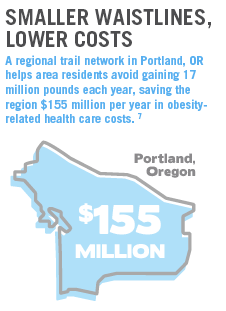
It isn't window dressing. Or a "hip cities" thing. Bike infrastructure -- not the watered-down stuff, but high-quality bikeways that get more people on bikes -- is becoming a must-have for cities around the U.S.
That's according to a new report from Bikes Belong and the Alliance for Biking and Walking. Researchers at these groups interviewed 15 business leaders from around the country about what impact bike facilities are having on their bottom line.
Here are the four main takeaways.
1. Bikeways make places more valuable
David Baker, founder and principal at David Baker + Partners Architects, is a huge proponent of the protected bike lane near his Second Street offices in San Francisco. It's crucial for keeping his employees safe on the way to work, he said. He also admitted liking it for "selfish" reasons.
“I own the office. I know that if we have protected bike lanes out there, it will improve my property value,” Baker told researchers.
There's data to back up this claim. A 2006 study found that in Minneapolis, median home values rose $510 for every quarter-mile they were located closer to an off-street bikeways. In Washington, D.C., 85 percent of nearby residents say the 15th Street bike lane is a valuable community asset.
2. Bikeways help companies attract talent
Founders of the Portland-based advertising start-up Pollinate used the firm's location in central Portland, and the nearby bikeways, to attract and build its team. About two-thirds of the company's employees bike commute at least occasionally.
Bike infrastructure "used to be a perk,” said Ben Waldron, co-founder. “Now it seems like it’s a right.”
Pollinate's experience seems to be a part of a larger trend. Several recent studies have shown that younger people are increasingly disenchanted with driving. The percentage of people age 16 to 24 with driver's license is lower than at any point since 1963. And among people 16 to 34, bike trips have increased 24 percent.
3. Bike commuters are healthier and more productive

According to a 2003 study by the U.S. Department of Health and Human Services, "workplace physical activity programs can reduce short-term sick leave by six to 32 percent, reduce health care costs by 20 to 55 percent, and increase productivity by 2 to 52 percent." While we don't know how much of those effects are due to biking, the benefits of integrating physical activity into daily routines are indisputable.
That's one of the reasons why Kaiser Permanente Northwest was a big supporter of new protected bike lanes outside its headquarters in Portland. Human Resources Director Shannon Mayorga said active commuting could help the company reach its cost-cutting goals.
“We’re really excited about the prospect of moving the needle with people who don’t typically have exposure to bike commuting," she said. “There’s an intrinsic value in community health."
4. Bike facilities increase retail stores' visibility and sales
There's plenty of evidence that bike infrastructure gives retail businesses a boost. According to a San Francisco State University study [PDF], 66 percent of shops on San Francisco's Valencia Street reported business improved after the city reduced the width for cars, and widened sidewalk and added bike infrastructure. A 2008 Australian study showed that per square foot, bike parking produced more than three times the revenue for businesses than car parking in an hour.
Tim League, founder and CEO of the Alamo Drafthouse Cinema in Austin, has seen the results in his own community.
“Commerce on a protected bike lane is great," he told People for Bikes and the Alliance, "because you don’t need the parking that you need for cars, and people can stop anytime they want to."





